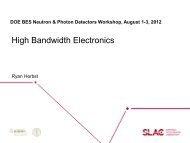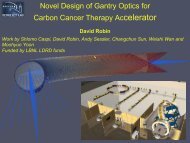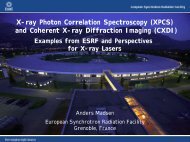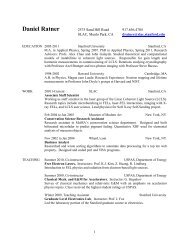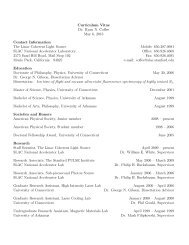SXR Technical Design Report - Stanford University
SXR Technical Design Report - Stanford University
SXR Technical Design Report - Stanford University
Create successful ePaper yourself
Turn your PDF publications into a flip-book with our unique Google optimized e-Paper software.
4. Optical <strong>Design</strong><br />
4. 1 Optical layout<br />
At synchrotron radiation sources, two of the most successful types of grating monochromators are the<br />
Varied-Line-Spacing grating monochromator (VLS) and the Plane Grating Monochromator (PGM). The VLS<br />
monochromator was developed by Underwood, Koike and coworkers at the Advanced Light Source (ALS). [2] A<br />
spherical mirror produces a converging beam in the vertical plane and a varied-line-spacing grating diffracts the x-<br />
rays onto an exit slit. The variable period of the grating provides additional parameters to keep the focal distance<br />
constant as a function of photon energy and to compensate for aberrations of the mirror. The focal plane is erect,<br />
which is convenient for implementing the spectrometer mode. The photon energy is scanned by a single rotation of<br />
the grating.<br />
The PGM monochromator was developed by Peterson, Follath and Senf at BESSY. [3] In the PGM<br />
monochromator a plane mirror reflects the x-rays onto the grating and an elliptical or spherical mirror focuses the<br />
beam onto the exit slit. The plane mirror provides a variable included angle on the grating, which allows the grating<br />
efficiency to be optimized over a wide photon energy range. The photon energy is scanned by coordinated rotations<br />
of both the plane mirror and grating.<br />
We have chosen the VLS monochromator type because of its simplicity. Only two optical elements are<br />
required, and only the grating rotates. The limited photon energy range of the <strong>SXR</strong> Instrument, 500 to 2000 eV,<br />
would not take advantage of the variable included angle of the PGM monochromator.<br />
Figure 4-1. Optical layout of the <strong>SXR</strong> Instrument.<br />
The optical layout of the <strong>SXR</strong> Instrument is shown in figure 1. Table 1 is a list of the optical elements and<br />
their parameters. The first component is experimental chamber 1, which is a location for samples in the unfocused<br />
non-monochromatic beam. Next, there is the M1 spherical mirror and G1 and G2 plane gratings of the VLS<br />
monochromator. In monochromator mode, an exit slit selects a narrow bandwidth. Alternatively in spectrometer<br />
mode, a detector will measure the dispersed x-ray absorption spectrum. The M2 plane elliptical mirror provides the<br />
horizontal focus in experimental chamber 2. The plane elliptical M3 mirror produces a vertical image of the exit slit<br />
at experimental chamber 2. The experimental chamber 2 provides the experimental environment for monochromatic<br />
and focused pink beam experiments. Endstation 1, the M1 mirror and gratings are in the first hutch of the LCLS<br />
Near Experimental Hall. The rest of the beamline from the exit slit and detector through the experimental chamber<br />
2 are in the second hutch.<br />
4.2 Optical elements<br />
The design of the optical elements adopts characteristics of the LCLS soft x-ray offset mirrors in the Front<br />
End Enclosure. The incidence angle of the mirrors is 89.14o equivalent to a grazing angle of 15 mrad. The mirror<br />
substrates are single crystal silicon, and the preferred optical coating is B4C. Figure 2 shows the reflectivity of B4C<br />
in comparison with other coating materials. The reflectivity of B4C is excellent about 90 % over the whole energy<br />
14



